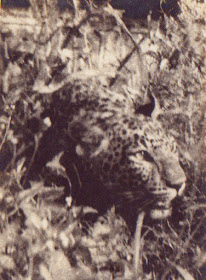Once upon a time, no its not that long, I was a boy of 15 years and studying in the 9th standard in my small town. Wild life week was at the doorstep. The Forest Department was organising many competitions for the school children. Essay writing, Poetry, Painting as also Photography. Every thing centred around wild life. Since I had my box camera, I thought of getting into the competitions. The problem, however, was where to get the wild animals. Then I remembered that there were some deers (antelopes) kept in a small enclosure within the local Palace compound. I went there with my box camera, only to be disappointed, as there was a tall wire mesh around the enclosure which prevented a clear view. Nevertheless I took some snaps but it was disgusting.
Two days later some one informed me that the tribals have caught a leopard and the same has been presented to the Maharaja and it is kept in a cage inside the palace. Once again I was on my way to the Palace. Immediately when we enter the main gate, to the left there is the famous Danteshwari temple. By its side there is one more enclosure with a gate. It leads to the living quarters of the staff and the garage where the limousines of the prince were kept. There it was, the leopard in a cage. A young tribal was also stationed nearby as its care taker. It was not fully grown, rather it was a cub. Again the problem was how to get a clear photograph. The iron bars in the cage were creating problem. I was not all alone. A friend of mine was also accompanying me. He looked around and found that to the left there was a compound wall with a small grilled entrance. Corn was grown inside and it almost looked like jungle. We thought if we could make the care taker bring out the leopard cub (which was chained) and take to the corn field, we may have a nice capture. I offered 2 Annas (1/8th of a Rupee) to the young tribal and sought his cooperation. With the money in his palm, he relented. He took out the cub from the cage and brought it inside the compound where corn was growing. With the chain in his hands, I was doubtful if I could get a photograph which could seem natural. I requested him to leave the chain but then he was not prepared. Alternatively I asked him to sit there with the chain touching the ground. He did that and I took two or three snaps. Two of them were out of focus but fortunately one snap came out reasonably well. This paved the way for my entry into the competitions. There was a little bit of disappointment, when I was awarded a third prize in the district level. Obviously the judges were looking at the picture quality and they had no inklings of the efforts put in. The prize consisted of a bundle of publications of the Forest Department.
Here is one more snap for which a flash bulb was used. For each flash a new bulb was required to be used which was a little prohibitive, cost-wise. The animal captured here, though belongs to the same family, but man has domesticated them.

















































